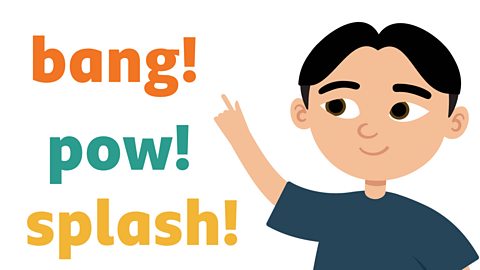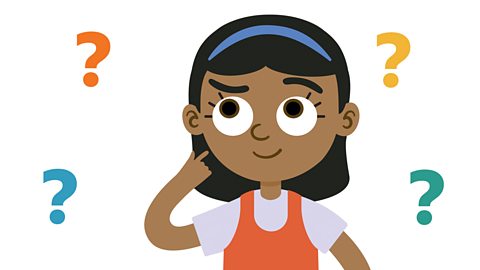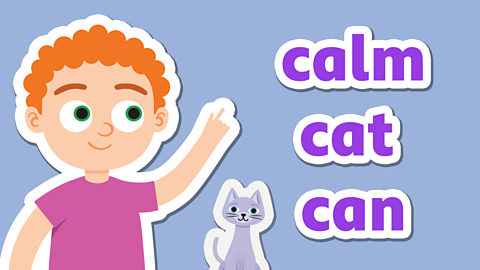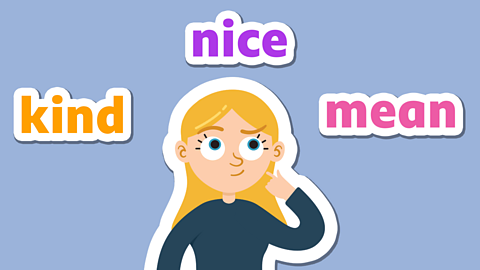Watch: What is onomatopoeia?
Onomatopoeia is a word which sounds like what it means.
'Thud', 'crash', 'bang' and 'buzz' are all examples. Can you think of any more?
Using onomatopeia
Onomatopoeia is when a word sounds like what it means.
Take chef here, he needs to wash up. But instead he is going to smash all the crockery in his kitchen.
SMASH against the ceiling! That is onomatopoeia in action.
THUD. That cleaver thudded into the wall. Onomatopoeia again!
BANG! More onomatopoeia!
Ahem. Er…chef do you want to show us anything more about onomatopoeia?
Let's just leave him to it.
Using onomatopoeia in poems

Onomatopoeia can help to bring a story or poem to life for the reader.
It is often used to add humour as well because the words usually sound quite strange or are fun to say.
Watch the following clip in which poet Joseph Coelho talks about onomatopoeia and how you could use it in a poem.
You only need to watch up to 1 minute and 23 seconds.

Joseph Coelho talks about making poetry fun.
When I was growing up, I thought poetry was very serious. It took me a long time to realise that it can be fun and that anyone can do it. At its heart, poetry is about having fun with words and the sounds that they make.
One of my favourite poetic devices is onomatopoeia. It's a long word, but simply means words that are also sounds. Words like moo, quack, roar, drip, drop, splash! By stringing sound words together it is possible to create a poem.
The cow goes moo and the duck goes quack
Roar goes the lion and drip goes the tap.
Drop goes the penny as it splashes into the well.
Plop goes the elephant dung and bad is the smell.
Onomatopoeia (sound words) are fun to play with because with sounds you get rhythms.
A splish splash splosh.
And a drip drop plop.
A rustle bustle tussle
And a slip slap slop.
Listening to the sounds around us can inspire poems. Poems that are just fun to say. They don't have to have a deep meaning in fact poems don't have to have any meaning at all they can be utter nonsense!
One way to create great nonsense poems is to first write some sentences about doing something very ordinary like brushing your teeth.
I pick up my toothbrush
Run my toothbrush under the tap
Squirt some toothpaste onto it
I put the toothbrush in my mouth
Then run the toothbrush over each tooth and my tongue
Going back and forth until it froths up.
Then just swap some of the words with random words. I'm going to swap toothbrush with hippopotamus and run with skedaddle and mouth with tuna fish and tongue with peanut butter. Now, the poem sounds like this.
I pick up my hippopotamus
Skedaddle my hippopotamus under the tap
Squirt some hippo paste onto it.
I put the hippopotamus into my tuna fish
Then run the hippopotamus over each hippo and my peanut butter
Going back and forth until it froths up.
There are nonsense poems waiting to be created from everyday descriptions of a journey on a bus or a trip to the shops, a visit to the bathroom or a trip to the zoo. It's just a matter of playing with words, swapping everyday words for words you find funny or words you like the sound of. It doesn't matter what they mean. You could even make up words like bloomlurgy, tangleflority, keyayaya, laykal wangdoolahlah!
When I realised you could make up words when writing poems, it didn't take long to realise that I could make up characters and situations. Maybe a zoo keeper without a zoo or a lion that quacks like a duck or a shrimp with a limp.
Poetry is fun! It's a playground for the imagination. I might write about some funny situations. Perhaps a carp who plays a harp or a pike that rides a bike or shark that's afraid of the dark!
Activity 1
Activity 2

Imagine you are visiting a zoo, like Joseph Coelho was in the previous video.
Write down a list of all the onomatopoeia words you might hear in a zoo and what is making those noises.
Aim to write at least eight noises in your list.
For example:
Roar = an angry tiger
Plop = a penguin jumping into the water
Rustle = branches in the insect house

Activity 3

Now try writing your own onomatopoeia poem.
You could use Joseph Coelho’s onomatopoeia poem from the video as inspiration.
For your poem you need to:
Write in sentences.
Write at least five lines.
Use a different onomatopoeia word in each line.
You could also:
Use rhyme (words that end with a similar sound).
Use alliteration (words that start with the same first sounds).
Add some illustrations to your poem showing pictures of the things that are making the sounds in the zoo.

Play Crystal Explorers to get ready for SATs. gamePlay Crystal Explorers to get ready for SATs
In this game, use grammar, punctuation and spelling skills to explore jungles, caves and tombs on your mission!

More on Creative writing
Find out more by working through a topic
- count3 of 25

- count4 of 25

- count6 of 25
